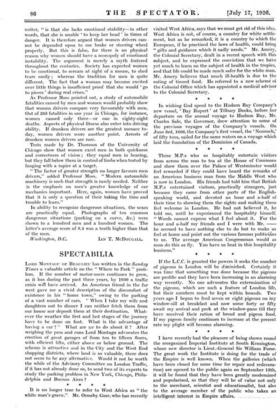AMERICAN WOMEN AS MOTOR DRIVERS
wHo is the better driver of an automobile, man or woman ? Popular opinion immediately answers, " Man, of course ! " Recent scientific experiments, however, testing the competency of both sexes, produced results favourable to women, according to an announce- ment lately made by the American Automobile Associa- tion. In the two attributes essential to safety—ability to react quickly in an emergency, and ability to show consistency in such reaction—women drivers proved slightly more capable than men.
The tests which led to this conclusion were conducted by Professor Fred A. Moss, head of the Psychology Depart- ment, George Washington University, Washington, D.C. Professor Moss is also a committee secretary of the Hoover Conference on Street and Highway Safety, and a member of the Committee on Drivers' Tests of the National Research Council. Mr. H. H. Allen, mechanical engineer of the United States Bureau of Standards, co-operated with Professor Moss in applying the tests to thirty-five univer- sity students, ten of whom were women.
Precautions were taken to test only such persons as had had approximately the same amount of experience in driving cars of standard gear shifts. The automobile used had two revolvers mounted on the under side of the running board. One was fired by the examiner, who sat by the person under test, as a signal to stop ; the other was fired by the driver when he made the initial motion to apply the brake pedal. The red lead with which the shells were filled made a bright spot on the ground whet) either revolver was discharged.
Maximum accuracy in speed measurements was obtained by discarding the ordinary speedometer and using a chronometric tachometer, attached to the trans- mission.
The driver's reaction time was obtained by dividing the distance between the two red spots by the speed at which the car was going when the revolvers were discharged. This showed how much time elapsed between the instant he heard the signal and made the initial motion to apply the brake. The average reaction time of the women was 0.56 seconds for a car making thirty miles an hour ; that of the men, 0.59 seconds.
A close relation appears to exist between reaction time and mental alertness, or general intelligence. The results of intelligence tests made over a period of ten years on thousands of men and women show only a slight, and therefore negligible, difference in intelligence between the sexes. Army alpha intelligence tests given by Professor Moss to five hundred men and five hundred women university students show an average score of 145 for the former, and of 146 for the latter. Though the difference in favour of women may have been due to chance selec- tion, it nevertheless emphasizes the women's victory in the reaction time test.
But, the doubtful ask, is the woman driver consistent in her quickness of reaction to danger ? Does she not show speedy response at one time but only an indifferent reaction the next time ?
Here, again, Professor Moss notes that the average variability of the women tested was 0.17 seconds, as compared with that of 0.22 seconds for the men. Sweep- ing conclusions cannot be made on this point, however, because of the small number of cases tested ; but the result is remarkable enough to weaken the stock argu- ment that women drivers--are erratic in emergencies.
" Perhaps the most frequent charge against a woman," continued Professor Moss in an interview with the writer, " is that she lacks emotional stability—in other words, that she is unable ' to keep her head' in times of danger. It is therefore argued that women drivers can- not be depended upon to use brake or steering wheel properly. But this is false, for there is no physical reason why women should have a monopoly of emotional instability. The argument is merely a myth foStered throughout the centuries. Society has expected women to be emotional, to scream at sight of a mouse, to shed tears easily ; whereas the tradition for men is quite different. The fact that a woman may become excited over little things is insufficient proof that she would go to pieces ' during real crises."
As Professor Moss pointed out, a study of automobile fatalities caused by men and women would probably show that women drivers compare very favourably with men. Out of 265 fatalities in one year in Chicago, for instance, women caused only three—or one in eighty-eight deaths. Aspects of physical fitness also enter into driving ability. If drunken drivers are the greatest menace to- day, women drivers score another point. Arrests of drunken women drivers are rare.
Tests made by Dr. Thomson of the University of Chicago show that women excel men in both quickness and correctness of vision ; _ they equal men in hearing, but they fall below them in control of limbs when tested by lunging with a rapier at a target.
" The factor of greater strength no longer favours men drivers," added Professor Moss. " Modern automobile machinery is such that strength is rarely needed. Neither is the emphasis on men's greater knowledge of car mechanics important. Here, again, women have proved that it is only a question of their taking the time and trouble to learn."
In ability to recognize dangerous situations, the sexes are practically equal. Photographs of ten common dangerous situations (parking on a curve, &c.) were shown to a hundred men and a hundred women. The latter's average score of 8.4 was a tenth higher than that of the men.











































 Previous page
Previous page